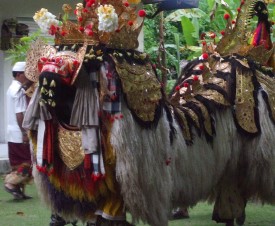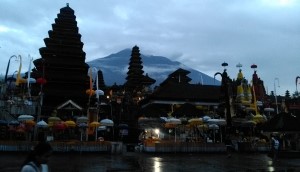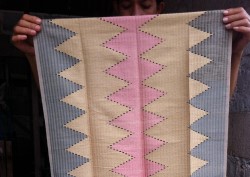Bali is a beautiful island in Indonesia that is known for its stunning beaches, lush rice paddies, and vibrant culture. In recent years, Bali has become a popular destination for digital nomads, who are drawn to the island's laid-back lifestyle, affordable cost of living, and rich cultural heritage.
If you are considering moving to Bali as a digital nomad, it is important to learn about Balinese culture. This article will provide you with an overview of Balinese culture, including its history, religion, arts and crafts, music and dance, food, and festivals.
The history and religion of Bali
Bali has a long and rich history, and it has been influenced by a variety of cultures, including Indian, Chinese, and Javanese. The Balinese people are an Austronesian ethnic group native to the Indonesian island of Bali. The Balinese originated from three periods of migration since prehistoric times. The Balinese from the first wave and second wave of immigration, known as the Bali Aga (Bali Mula), the earliest inhabitants of Bali. The Bali Aga were animists, who believed in a spirit world that was populated by gods, demons, and other supernatural beings.
The development of Hinduism in Bali is thought to have been influenced by Central Java and East Java. Hinduism entered Bali before the 8th century AD, as evidenced by inscriptions in the village of Pejeng, Gianyar Regency, which were written in Sanskrit. An expert, Dr. R. Goris, believes that the inscription contains the word "Siva Siddhanta". This suggests that the siwa siddhanta teaching had already developed in Bali by the 8th century AD.
The Sukawana Inscription in Bangli Regency, which dates back to 882 AD, also provides evidence of the development of Hinduism in Bali. This inscription mentions three religious figures, Bhiksu Sivaprajna, Bhiksu Siwa Nirmala, and Bhiksu Sivakangsita, who built a hermitage in Cintamani (in Kintamani). The syncretism between Shiva and Buddha that is evident in these inscriptions is also a characteristic of Balinese Hinduism.
In the 19th century, Bali came under Dutch rule. The Dutch imposed their own laws and customs on the island, but they did not try to suppress Balinese culture. As a result, Balinese culture has remained largely intact, and it is one of the most vibrant and unique cultures in Southeast Asia.
The Balinese people are predominantly Hindu, and their religion is a syncretic mix of Hinduism, Buddhism, and animism. The Balinese believe in a supreme being called Sang Hyang Widhi Wasa, who is believed to have created the universe. They also believe in a number of other gods and goddesses, as well as spirits and demons.
Balinese Hinduism is a complex and multifaceted religion, and it plays an important role in the daily lives of the Balinese people. The Balinese regularly attend temple ceremonies, make offerings to the gods and spirits, and follow a strict set of religious rules and regulations. If you are interested in learning more about Balinese culture, it is a good idea to learn more about Balinese Hinduism.
The arts and crafts of Bali
Bali is home to a rich tradition of arts and crafts. Some of the most popular Balinese arts and crafts include wood carving, metalwork, weaving, painting, and sculpture. These arts and crafts are often used to depict religious themes, as well as everyday life in Bali.
- Wood Carving is one of the most popular Balinese arts and crafts. Balinese woodcarvers use a variety of woods, including teak, mahogany, ebony, and sandalwood. It is used to create a variety of objects, including furniture, sculptures, masks, and religious artefacts. Wood carving is a highly skilled craft, and the Balinese woodcarvers are known for their intricate and detailed work.
- Metalwork is another popular Balinese art form. Balinese metalworkers use a variety of metals, including gold, silver, and bronze. It is used to create a variety of objects, including jewelry, utensils, ritual objects, and weapons. Balinese metalworkers are known for their use of intricate patterns and designs.
- Weaving is a traditional Balinese craft that is used to create a variety of textiles, including sarongs, batik, blankets, songket, and bags. Balinese weavers use a variety of natural fibers, including cotton, silk, and bamboo. The weaving is done on a backstrap loom, which allows the weaver to create intricate patterns and designs.
- Painting is another popular Balinese art form. Balinese painters often create paintings of religious scenes, landscapes, and everyday life. They use a variety of materials, including natural dyes and pigments. They create a wide range of objects, such as paintings, murals, and batik.
- Sculpture is another popular Balinese art form. Balinese sculpture is known for its use of wood, stone, and metal. They create a wide range of objects, such as statues of gods and goddesses, mythical creatures, animals, plants, reliefs, and masks.
The arts and crafts of Bali are still practiced today. There are many traditional villages in Bali where artisans continue to practice these crafts. The arts and crafts of Bali are a testament to the island's rich cultural heritage.
The music and dance of Bali
Bali is known for its vibrant music and dance scene. The island is home to a variety of traditional music and dance forms, which are often used to depict religious themes, as well as everyday life in Bali. Some of the most popular Balinese music and dance forms include gamelan, kecak, and barong ket.
- Gamelan is a type of orchestral music that is played on a variety of instruments, including gongs, drums, and metallophones. Gamelan is often used to accompany religious ceremonies and traditional dances. The instruments are played by striking them with mallets or by rubbing them with a stick. Gamelan music is often complex and rhythmic, and it can be very beautiful and moving.
- Kecak is a type of chant that is performed by a group of men. Kecak is often used to accompany the Ramayana story, which is a popular Hindu epic. The Kecak chant is made up of a single word, "cak," which is repeated over and over again. The men who perform the Kecak chant form a circle and move their arms and bodies in a rhythmic fashion. Kecak is a very energetic and powerful form of music and dance.
- Barong Ket is a type of dance that features a mythical creature called the Barong. The Barong is a symbol of good, and it is often depicted fighting against a mythical creature called the Rangda, which is a symbol of evil. Barong ket dances are often used to ward off evil spirits and to celebrate religious festivals. The dancers wear elaborate costumes and masks, and they move their bodies in a graceful and acrobatic fashion. The Barong ket dance is a popular tourist attraction in Bali.
These music and dance forms are an important part of Balinese culture. They are often used to celebrate religious festivals, important life events, and other occasions. They also play a role in educating the younger generation about Balinese culture and history.
The food of Bali
Balinese cuisine is a delicious and diverse blend of Indonesian, Chinese, and Indian influences. The island's rich history and culture have shaped the unique flavors and ingredients that are used in Balinese cooking. Some of the most popular Balinese dishes include nasi campur, sate lilit, and lawar.
- Nasi Campur is a rice dish that is served with a variety of side dishes, such as satay, vegetables, and sambal. The rice is often cooked with coconut milk and spices, and it is served with a variety of vegetables, such as cucumbers, tomatoes, and bean sprouts. Nasi campur is a popular breakfast dish in Bali, and it is also a good option for lunch or dinner.
- Sate Lilit is a type of grilled skewered meat that is made with minced meat, spices, and coconut milk. The meat is minced and then mixed with spices and coconut milk. The mixture is then formed into small balls and skewered on bamboo sticks. The sate lilit is then grilled over a fire. Sate lilit is a popular snack or appetizer in Bali, and it is also a good option for a light lunch.
- Lawar is a type of salad that is made with shredded meat, vegetables, and blood. The meat is shredded and then mixed with vegetables, such as onions, tomatoes, and beans. The mixture is then seasoned with spices and blood. Lawar is a popular dish in Bali, and it is often served as an accompaniment to nasi campur.
- Babi Guling is a traditional Balinese roasted pork dish. The pork is roasted over an open fire and is then served with a variety of side dishes, such as satay, lawar, and sambal matah.
Balinese food is also influenced by the island's Hindu religion. Balinese Hindus do not eat beef, so many Balinese dishes are made with chicken, pork, or fish. Balinese Hindus also believe in the importance of harmony and balance, so their food is often made with a variety of flavors and textures.
Balinese food is not only delicious, but it is also healthy. Many Balinese dishes are made with organic ingredients and cooked in a healthy way. The island's tropical climate also allows for the use of fresh fruits and vegetables, such as pineapple, mango, and papaya. Balinese cuisine is a great way to experience the island's rich culture and history.
The festivals of Bali
Bali is known for its many festivals, which are celebrated throughout the year. These festivals are an important part of Balinese culture and are a way for the people of Bali to celebrate their religion, history, and mythology. Some of the most popular festivals in Bali include:
- Nyepi is the Balinese New Year, and it is celebrated on the day of the new moon in March or April. Nyepi is a day of silence and introspection, and it is a time for the people of Bali to reflect on the past year and to make resolutions for the new year. During Nyepi, no one is allowed to leave their homes, and all businesses and activities are closed.
- Galungan is a festival that celebrates the victory of good over evil. Galungan is celebrated for ten days, and during this time, the people of Bali decorate their homes with penjor, which are bamboo poles decorated with flowers and fruit. Galungan is also a time for the people of Bali to visit their local temples and to offer prayers to their gods and ancestors.
- Kuningan is a festival that celebrates the return of the souls of the dead to the world of the living. Kuningan is celebrated on the 10th day of Galungan, and it is a time for the people of Bali to remember their ancestors and to pray for their well-being.
- Mekare-kare is a Balinese tradition of ritual combat with clubs made of pandan leaves. It is practiced by the Bali Aga population of Tenganan village in Karangasem Regency, Indonesia. The people of Tenganan are devotees of the deity Indra. Mageret pandan is part of a month-long ceremony called Usabha Sambah, which is a ritual to honor the gods, especially Indra, and also to honor the ancestors. The ceremony is held every sasih Kalima, which is the fifth month on the Balinese calendar, around June.
- Melasti is a ritual cleansing ceremony that is performed on the eve of Nyepi. The people of Bali carry offerings to the sea or to a river, and they pray for the purification of the world.
- Omed-omedan is a festival that celebrates love and relationships. Omed-omedan is celebrated by the young people of Banjar Kaja Sesetan, Denpasar, Bali. It is held on the day of Ngembak Geni, which is the day after Nyepi, the Balinese New Year. The ceremony is performed to strengthen friendships, maintain harmony, and solidarity among the people. It is also a place where singles can meet and mingle. In fact, many couples have met through this tradition.
- Tumpek Landep is a festival that celebrates the power of fire. Tumpek Landep is celebrated by sharpening knives and other metal tools. It is also a time for the people of Bali to make offerings to the gods of fire.
These are just a few of the many festivals that are celebrated in Bali. These festivals are an important part of Balinese culture and are a way for the people of Bali to celebrate their religion, history, and mythology.
Common FAQs about Balinese culture
Here are some common FAQs about Balinese culture:
What are some of the most popular Balinese arts and crafts?
Some of the most popular Balinese arts and crafts include wood carving, metalwork, weaving, painting, and sculpture. These arts and crafts are often used to depict religious themes, as well as everyday life in Bali.
What are some of the most popular Balinese music and dance forms?
Some of the most popular Balinese music and dance forms include gamelan, kecak, and barong ket. Gamelan is a type of orchestral music that is played on a variety of instruments, including gongs, drums, and metallophones. Kecak is a type of chant that is performed by a group of men. Barong ket is a type of dance that features a mythical creature called the Barong.
What are some of the most popular Balinese dishes?
Some of the most popular Balinese dishes include nasi campur, sate lilit, and lawar. Nasi campur is a rice dish that is served with a variety of side dishes, such as satay, vegetables, and sambal. Sate lilit is a type of grilled skewered meat that is made with minced meat, spices, and coconut milk. Lawar is a type of salad that is made with shredded meat, vegetables, and blood.
What are some of the most popular Balinese festivals?
Some of the most popular Balinese festivals include Nyepi, Galungan, and Kuningan. Nyepi is a day of silence that is celebrated at the beginning of the Balinese new year. Galungan is a festival that celebrates the victory of good over evil. Kuningan is a festival that celebrates the return of the souls of the dead to the world of the living.
How do you experience Balinese culture?
There are many ways to experience Balinese culture. You can visit temples (Tanah Lot or Besakih), watch traditional dances (Kecak Dance or the Barong Ket Dance), learn about Balinese arts and crafts, visit a local market, or simply interact with the local people.
What is traditional Balinese culture?
Traditional Balinese culture is a rich and diverse culture that has been influenced by a variety of cultures over the centuries. The island was originally inhabited by a group of people known as the Bali Aga, who were later influenced by Indian culture. Balinese people believe in a supreme being known as Sang Hyang Widhi Wasa, and they believe in a cycle of reincarnation. Balinese people are very welcoming and friendly, and they enjoy spending time with their families and friends.
How do you say thank you in Balinese?
The most common way to say thank you in Balinese is "matur suksma". This phrase can be used in both formal and informal settings.
How do you show respect in Bali?
There are a few ways to show respect in Bali. One way is to dress modestly. Another way is to avoid touching people's heads, as this is considered to be disrespectful. You should also avoid pointing your feet at people or objects, as this is also considered to be disrespectful.
Why do Westerners love Bali?
There are many reasons why Westerners love Bali. Some of the reasons include the beautiful beaches, lush green rice paddies, friendly and welcoming people, rich culture and history, delicious food, and affordable cost of living
What is the most cultural place in Bali?
There are many cultural places in Bali, but some of the most popular include: (1) Ubud is known for its spiritual atmosphere and its many temples and art galleries, (2) Tanah Lot is a beautiful temple that is located on a cliff overlooking the ocean, (3) Besakih is the largest and most important temple in Bali, (4) Seminyak is a popular tourist destination that is known for its vibrant nightlife and its many shops and restaurants, and (5) Canggu is a laid-back beach town that is known for its surfing and its vibrant arts and culture scene.
Tips in learning Balinese culture
Here are some tips for digital nomads who are interested in learning about Balinese culture:
- Do your research. Before you travel to Bali, take some time to learn about the history, religion, and culture of the island. This will help you to understand the customs and traditions of the Balinese people, and it will make your trip more enjoyable.
- Be respectful. Bali is a Hindu island, so it is important to be respectful of the local customs and traditions. This means dressing modestly, avoiding touching people's heads, and pointing your feet at people or objects.
- Learn some basic Balinese phrases. Learning a few basic Balinese phrases will show the locals that you are interested in their culture. Some common phrases include: "matur suksma" (thank you), "inggih" (yes), and "om swastiastu" (a greeting).
- Attend a traditional ceremony. There are many traditional ceremonies that take place in Bali throughout the year. Attending one of these ceremonies is a great way to learn about Balinese culture and to experience the rich spiritual life of the island.
- Visit a local village. One of the best ways to experience Balinese culture is to visit a local village. This will give you the opportunity to meet the locals, learn about their way of life, and see how they live.
- Try traditional Balinese food. Balinese cuisine is a delicious and diverse blend of Indonesian, Chinese, and Indian influences. Be sure to try some of the local dishes, such as nasi campur, sate lilit, lawar and babi guling.
- Attend a festival. Bali is home to a number of festivals throughout the year. These festivals are a great way to experience the rich cultural life of the island. Some of the most popular festivals include Nyepi, Galungan, and Kuningan.
Video link: https://youtu.be/JWfd2PfXbRU
Conclusion
Bali is a beautiful island with a rich culture that is sure to fascinate digital nomads. This article has provided an overview of Balinese culture, including its history, religion, arts and crafts, music and dance, food, and festivals. If you are considering moving to Bali as a digital nomad, I encourage you to learn more about Balinese culture and to experience it for yourself. I hope you enjoyed this article!
Reference
- google.co.id
- wikipedia.org _ Balinese People _ on July 29, 2023
https://en.wikipedia.org/wiki/Balinese_people - wikipedia.org _ Balinese Hinduism _ on July 29, 2023
https://en.wikipedia.org/wiki/Balinese_Hinduism - Image : Original Collection
Searches on this site related to culture in Bali:
1. Food in Bali
2. Best Places to Stay in Bali
3. Things to Do in Bali
4. Hidden Gems of Bali








No comments:
Post a Comment